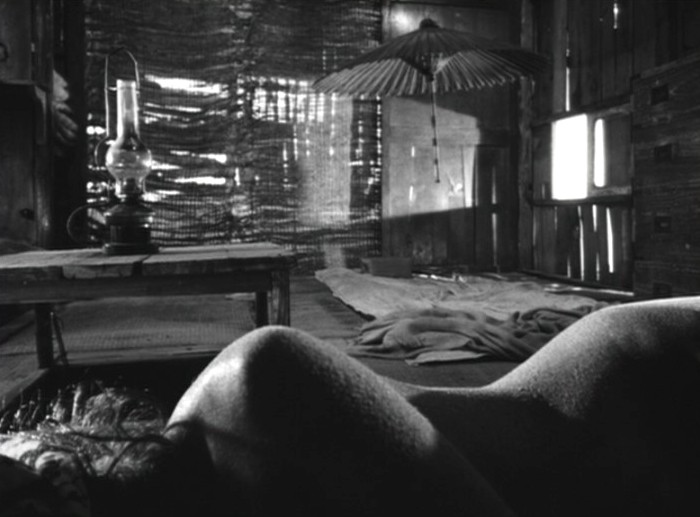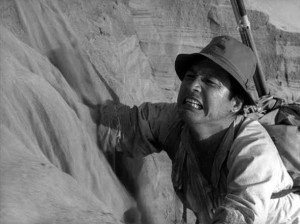
“Do you shovel to survive, or survive to shovel?” – The Man
A masterpiece so obscure that I doubt most major critics have even seen it. Woman in the Dunes (1964, Japan) is a parable and visual poem that defies conventional description since it resists realism. It is also what the DVD box quote promises: “Haunting. Erotic. Unforgettable.” Sovereign rulers of nondescript power are perched atop a hill. Beneath are desert canyons, with people lodged in the dunes like inhabitants of an ant colony. The woman (Kyoko Kishida) needs a companion, so the village rulers trick a man (Eiji Okada) into the pit with promise of a hospice, and then permanently remove the ladder. The man, desperate for freedom, attempts to climb and scale the wall of sand only to slide down in vain again and again.
 The man was simply a traveler on an entomology expedition. But he told no one from the city about his whereabouts, this makes him vanished from civilization. The man must now live in the dunes – to serve as companion to the woman of the dwelling. It is not an ideal living situation, he detests it. Equally, he detests the woman. A few days there he realizes it is futile to complain. A little time after that, the man accepts the woman’s sexual invitation. He learns to make the most of his spare surroundings, until he can devise an escape. Two forces operate to deny him escape: the rulers and the woman. Perhaps the woman loves the man simply because when there is no one else, you love best what is in front of you. Likewise, this is apt the case for him as well.
The man was simply a traveler on an entomology expedition. But he told no one from the city about his whereabouts, this makes him vanished from civilization. The man must now live in the dunes – to serve as companion to the woman of the dwelling. It is not an ideal living situation, he detests it. Equally, he detests the woman. A few days there he realizes it is futile to complain. A little time after that, the man accepts the woman’s sexual invitation. He learns to make the most of his spare surroundings, until he can devise an escape. Two forces operate to deny him escape: the rulers and the woman. Perhaps the woman loves the man simply because when there is no one else, you love best what is in front of you. Likewise, this is apt the case for him as well.
Hiroshi Teshigahara’s film is the best Japanese film ever made. The great desert sand film, according to mainstream lore, has always been “Lawrence of Arabia” (1962). But that’s only because many have never seen the  Teshigahara film which breaks open the conventional possibilities of what you can do and how you can photograph cascading sand and desert storms. If you’ve never seen it, how can you judge? Obvious, film society can be an ethnocentric hub of favoritism pushing English-language films. But you’ve read this far, you’re of an adventurous mind, and now you know you must see “Woman in the Dunes.”
Teshigahara film which breaks open the conventional possibilities of what you can do and how you can photograph cascading sand and desert storms. If you’ve never seen it, how can you judge? Obvious, film society can be an ethnocentric hub of favoritism pushing English-language films. But you’ve read this far, you’re of an adventurous mind, and now you know you must see “Woman in the Dunes.”
I also recommend Teshigahara’s eerie tale “Pitfall” (1962) about laborers on a construction site haunted by a ghostly autocrat out to rob them of their human spirits.
123 Minutes. Rated NR, but for mature audiences only.
Film Cousins: “Pitfall” (1962, Japan); “Walkabout” (1971); “Swept Away by an Unusual Destiny in the Blue Sea” (1976, Italy); “The Truman Show” (1998).





